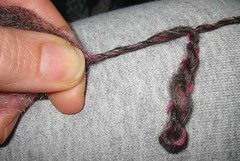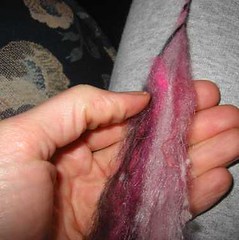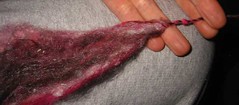One of the things I remember from when I was learning to spin, was fighting overspin. To overcome this, I pushed myself to the other end of the curve, underspin, by putting only a little twist in and then tugging -- if the not-yarn drifted apart, then it wasn't yarn yet. If it hung together, then it was yarn! So try putting in just a little twist, tugging, and seeing if it drifts; repeat until it stops drifting, and then you'll have the minimum amount of twist to make it yarn.
 That low-twist yarn makes great singles! But for plying you'll want to put in enough twist to make it "pretty" as a 2-ply. I recommend the ply-back test for measuring the "pretty".
That low-twist yarn makes great singles! But for plying you'll want to put in enough twist to make it "pretty" as a 2-ply. I recommend the ply-back test for measuring the "pretty". For more information on controlling twist in singles, see my entry How do I make sure my singles aren't underspun?
Joins are often a high-twist area. That's okay, really, as it helps them hang together. But if you want to avoid a high-twist join, make sure you have enough fiber in the old end and in the new end that they can be drafted at the same time. This will help make the join practically disappear -- and only "need" as much twist as the surrounding fibers to hang together well.
I like a "V-join" to help sandwich the new fibers and co-draft the two together. My bigger posting How do you spin a batt? covered this, but the details are repeated here:
 To join the fluffy end to a new segment:
To join the fluffy end to a new segment:
* split the end into a V
* draft out the tip of the new segment (to "fit" into the V)
* tuck the new segment into the base of the V, and ...
 ... Enclose the new segment in the V from the old one. From here, you draft the old and new together, and you have an excellent join!
... Enclose the new segment in the V from the old one. From here, you draft the old and new together, and you have an excellent join!
 Once you draft the V and new segment together and twist moves into both fiber sources, the join is formed and you are off and spinning on the next segment!
Once you draft the V and new segment together and twist moves into both fiber sources, the join is formed and you are off and spinning on the next segment!
(this was based on some of my flickr pictures and discussion contributions on the flickr groups SpindleShots and Spin and Knit)
